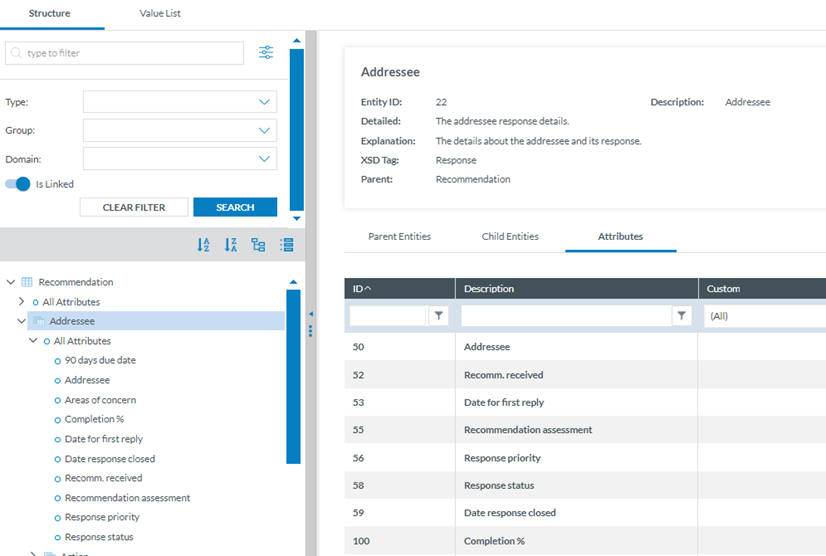5.3. Taxonomy structure
ECCAIRS and SRIS taxonomies have the same structure in 4 levels:
-
Entities
-
Attributes
-
Value Lists
-
Values
5.3.1 Entities
Entities represent objects to which attributes are assigned.
An entity could be, for example, the "Aircraft" involved in an incident or the "Events" describing the incident.
Multiple instances of an entity can exist if several such objects are involved in an event.
Entities can have child entities, e.g. "Engine" is a child entity of "Aircraft". Entities can also be linked to other entities.
5.3.1.1 Entities information
Entities in the Taxonomy tree are marked with icon  . When the Entity is a Linked Entity, it is also marked in green colour.
. When the Entity is a Linked Entity, it is also marked in green colour.
The following information will be displayed on the right side of the screen when the Officer clicks on an Entity in the Taxonomy tree:
· Entity information: A summary of the selected Entity.
· Parent Entities: The list of its parent Entities
· Child Entities: The list of its children Entities
· Attributes. The list of its Attributes
Click on each tab (Parent Entities, Child Entities, Attributes) to view the relevant information:
5.3.2 Attributes
Attributes describe properties/values associated with an entity. An attribute of the “Aircraft” entity is, for instance, its "manufacturer/model". Attributes can have single or multiple values.
-
Number
-
Decimals
-
Text
-
Alphanumeric
-
Date
-
Time
-
DateTime
-
Longitude
-
Latitude
-
Code
-
Code and Additional Text
-
Code or Alternative Text
-
ECCAIRS Resource Locator
-
ECCAIRS Data Link
-
ECCAIRS Embedded Data
5.3.2.1 Attributes information
The Attributes are marked with  icon in the Taxonomy Tree.
icon in the Taxonomy Tree.
The Officer can view the information of an Attribute from two places in the Taxonomy Browser:
a. Find an attribute in the Taxonomy Tree and click it:
b. Select the Entity to which the Attribute belongs and click on the 'Attribute' tab. The Officer will see all the Attributes of the selected Entity.
Click on the 'Eye' icon to view the detailed information.
· Definition
- Values: If the Attribute has a predefined value List. In the Values tree, the Officer can navigate the values by clicking on each element. The selected value will display its definition, and the Values can be searched by Taxonomy code or description and ordered alphabetically.
5.3.3 Value Lists
The list of values an attribute can have is defined in a Value List. The Value List can have multiple levels where values are organised in a tree mode. Each Value List can have Aliases.
5.3.4. Values
Values assigned to an attribute depend on the type of the Attribute. These can be manually inputted or selected from a predefined list of values (Value List).
5.3.5. Filter the information
The Officer can filter the Parent Entities, Child Entities and Attributes table by typing the term to be searched in the filter row. The Officer can restrict the results by clicking the  ' filter' button. By default, the 'contains' condition is selected.
' filter' button. By default, the 'contains' condition is selected.
To delete the filter, the Officer must click the '  clear filter' icon.
clear filter' icon.
5.3.6. View detailed information
To view more information about the select Entity, the Officer must click the 'eye' icon.
To view more information about the Parent Entities, Child Entities or Attributes, the Officer can click the 'eye' icon that appears while moving the mouse over the row.
A slide-in panel with the element information will be displayed when clicking on the' eye' icon. The Officer can click outside the panel to close it and return to the previous screen.










No comments to display
No comments to display